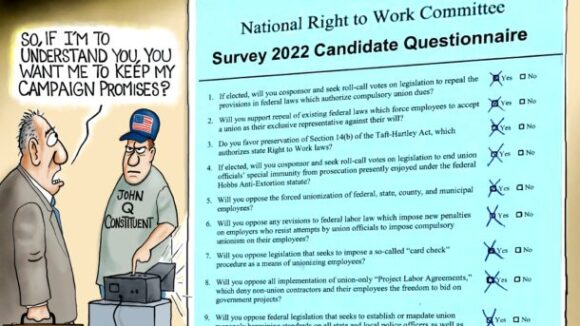Committee Tells Politicians: Stop Waffling
Members Insist They Keep Pro-Right to Work Campaign Promises
From the Washington Examiner:
In 1997, legendary journalist Robert Novak summed up renewed interest in the Right-to-Work issue thusly: “It’s so old-fashioned it’s a brand new idea.”
Over a decade later, that observation still rings true. Faced with intractable budget crises and Big Labor power grabs, states are increasingly turning to an old solution — Right-to-Work laws — to protect worker freedom and jump-start their troubled economies.
Thirteen states recently introduced Right-to-Work legislation to ensure no worker can be forced to join a union or pay union dues as a condition of employment, and a number of others may soon join them.
In New Hampshire, a Right-to-Work bill has already sailed through the lower chamber. In Indiana, another Right-to-Work bill was in the offing until Gov. Mitch Daniels abruptly decided he had “other priorities.” Apparently, freedom of association didn’t merit inclusion in Daniels’ supposedly “bold” governing agenda.
Meanwhile, several Michigan lawmakers are considering special “Right-to-Work zones” in a state long considered a bastion of forced unionism. While hardly adequate to fully protect employee choice, these embryonic reform proposals point to a significant shift in state labor politics.
The impetus behind this wave of Right-to-Work legislation isn’t a mystery: Big budget deficits, declining revenues and slumping economic growth have forced many states to reconsider their fiscal priorities, while a prolonged recession has legislators scrambling for policies with a proven record of job creation.
Fortunately, renewed interest in Right-to-Work happens to coincide with a historic opportunity. In November, voters across the country kicked many of Big Labor’s loudest forced-unionism apologists out of statehouses, where they once wielded tremendous power to obstruct or block Right-to-Work legislation.
The logic of state Right-to-Work laws is ironclad: Not only is safeguarding worker freedom the right thing to do, it also yields tremendous economic benefits. Recent studies from the Cato Institute and the National Institute for Labor Relations Research suggest that Right-to-Work states enjoy higher job growth and more cost-of-living-adjusted disposable income for workers than their forced-unionism counterparts.
They also seem to be weathering the recession better than old Midwestern industrial bastions like Michigan, Illinois and Indiana, states that lack protections for individual workers’ rights. (Click to read full article)
Op-Ed by Mark Mix is president of the National Right-to-Work Committee.

Members Insist They Keep Pro-Right to Work Campaign Promises
Brief challenges Labor Board’s attempt to expand coercive, anti-employee organizing scheme

Josh Hawley distances himself from pro-Right to Work pledges, aligning with union bosses like the Teamsters, despite their history of corruption.